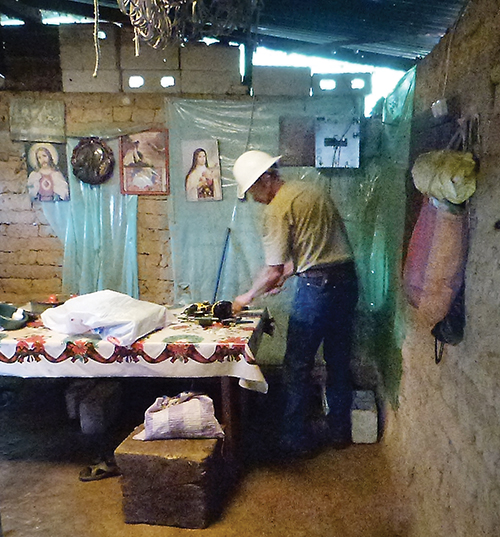by Diane Willis, Special Correspondent
Bringing power and light to people who’ve never had it before may not be a miracle, but it is a mission.
And it was a historic mission that 28 rural electric cooperative linemen and four field supervisors from across Indiana accomplished this summer. They brought power to the people in isolated villages high in the Frontier Zone of western Guatemala, near the Mexican border.
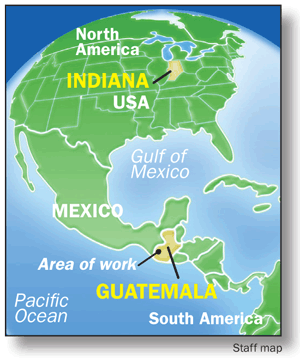 The mission transformed the lives of more than 1,000 Guatemalan men, women and children. But, in unexpected ways, it also changed the lives of the Hoosier linemen who volunteered and undertook the challenge.
The mission transformed the lives of more than 1,000 Guatemalan men, women and children. But, in unexpected ways, it also changed the lives of the Hoosier linemen who volunteered and undertook the challenge.
The work wasn’t easy — even for linemen trained and accustomed to facing challenges, danger and the unexpected every day. But there are no jungles in Indiana; no working above the clouds in 7,000-foot-high, unmapped mountains; no stringing 1,200-foot spans of electric wire across gorges, without paved roads or bucket trucks or machinery. Indiana linemen restore power after ice storms, tornadoes and hurricanes. It’s part of their job. But this work assignment was unlike anything they had ever experienced.
The challenge
From the start, project leaders Gayvin Strantz and Terry Adkins, with the Job Training and Safety Department of the Indiana Statewide Association of Rural Electric Cooperatives, were candid about the volunteer project. “It’s going to be the toughest job we’ve ever done,” they told the linemen and their wives beforehand.
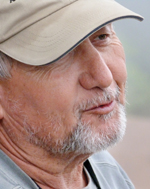 “The working conditions are like nothing you’ve ever seen. All the work will be by hand. You won’t just get into your truck and drive to the site. You’ll climb mountains straight up or straight down. There’s no level ground. I’m not guaranteeing you much,” Strantz emphasized, “just plenty of work, a place to sleep and food to eat. And you’d better like to eat rice and beans and corn tortillas. But our Number One goal is safety: 29 men will go in, and 29 men will come out. That’s our promise. You’re like family to us.”
“The working conditions are like nothing you’ve ever seen. All the work will be by hand. You won’t just get into your truck and drive to the site. You’ll climb mountains straight up or straight down. There’s no level ground. I’m not guaranteeing you much,” Strantz emphasized, “just plenty of work, a place to sleep and food to eat. And you’d better like to eat rice and beans and corn tortillas. But our Number One goal is safety: 29 men will go in, and 29 men will come out. That’s our promise. You’re like family to us.”
Fifty linemen volunteered for the slots that ultimately were filled by 28 current linemen. In addition to Strantz and Adkins, Randy Price, CEO at Carroll White REMC and a former lineman himself, and Dennis Weiss, CEO at Kankakee Valley REMC and an engineer, made the journey serving as field supervisors.
“This is a mission trip for me,” said Rob Hunger, a lineman with Southeastern Indiana REMC, before embarking. “The donation is me, and I’m going to try to be a good worker for them. It’s what I’m good at.”
It took nearly a year to plan and mobilize the equipment, material, supplies and manpower needed for one month of work 1,800 miles from Indiana. Even the logistics were a challenge. There was no potable drinking water. Fuel and basic supplies were a two-hour drive away on treacherous, unpaved roads. Working conditions were primitive — work was done by hand and even material was hauled in by hand. A hospital for emergency medical care was far away.
Changing lives
So what was the result? The project forever changed the lives of the Guatemalan villagers themselves. And the Hoosiers Power the World mission also made history. For the first time, a delegation of Indiana linemen served a worldwide community. The project became the biggest and was one of the toughest projects ever undertaken and completed for the National Rural Electric Cooperative Association’s International Program, which initiated the project.
The NRECA International Program, begun under the invitation of President John F. Kennedy and celebrating its 50th anniversary this month, has now provided safe and reliable electric service to more than 100 million people in 40-plus countries worldwide.
The numbers of the Hoosier mission tell the story. Working 10-hour days, the Indiana linemen — along with the help of local villagers — built more than 20 miles of power lines, at times digging holes and setting poles by hand. By the end of four weeks, the linemen brought safe, reliable electricity to between 150 and 175 homes, businesses and churches, linking families in these mountainous jungles to the power grid. But it was more than stringing power lines — they left an imprint that will redirect people’s lives there forever in a place where living conditions are harsh and primitive.
“Don’t get me wrong,” said Strantz, manager of the statewide association’s Job Training, Safety and Loss Control. “There are plenty of people in this country who need help, and we’re there to provide it. We live in the greatest country in the world with more resources to help our own. But down there, they don’t have those resources. … We gave something to people that don’t have the opportunity to get it any other way. If we wouldn’t have gone in there and helped them, there’s no doubt in my mind this project wouldn’t have gotten done.”
The people are Mayan and Quiché Indians who eke out a subsistence living in the Cuchumatanes Mountains, the highest non-volcanic mountain range in Central America. Many of these indigenous people fled to the mountains during Guatemala’s bloody 36-year civil war. Villagers here grow corn and some of the finest coffee beans in the world, cultivating every available scrap of rocky soil, planting the crops literally up and down the nearly 90-degree sides of the mountains. With dirt floors, and without running water, plumbing, heat or light (except from firewood, candles or kerosene) in their homes, these rural Guatemalans earn far less than the country average of $4,500 a year.
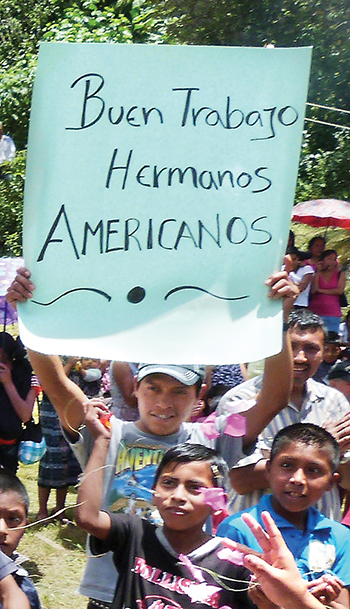
“Good Work American Brothers” reads this sign held during a farewell fiesta in honor of Indiana electric cooperative linemen after completing their mission of electrifying three remote Guatemalan mountain villages.
The area the linemen served is one of the poorest parts of one of the poorest countries in Central and Latin America. Having electricity will make it possible for the most isolated of the villages to build its first school. It will mean families can see after the sun goes down, and children can study at night without candles or kerosene lamps. It will mean women won’t to have to cook over an open wood stove or walk for miles to grind their corn. It will mean farmers can earn more to support their families by raising more crops and processing their coffee beans themselves. And electricity is safer and less costly than kerosene or wood — costing roughly $20 a year per family.
Each day during the project, the Guatemalan villagers worked side-by-side with the linemen. “If it wouldn’t have been for the Guatemalan people helping us, this project would never have gotten done. They were amazing,” said Adkins, senior loss control/risk management specialist with Indiana Statewide. “They work just to survive, just to live, day by day.”
Almost three out of four children under age 5 in Guatemala’s mountains are malnourished, according to the World Bank. The country has the fourth highest rate of chronic malnutrition in the world, and the highest rate in the Western Hemisphere. It’s those children’s faces that the linemen remember.
“In the end, it’s about the future — the children of Guatemala. That’s why we were there,” Strantz added. “Deep down, we know they’re going to have a better life. None of us will ever forget what we did in Guatemala and what we had an opportunity to achieve. And truthfully, when we stop and take a look at it, God gave us that opportunity to achieve what we achieved.”
When the lights came on
Sharp images stay with all of us who went to Guatemala. The hard life is reflected in the faces, like that of 59-year-old Yasly Yasely Velasquez. We knew her as “Abuela” or “grandmother.” She invited us into the simple shack where she cooked over a smoky woodfire, and pointed to her lungs and her red, irritated eyes. “The smoke burns my eyes and my daughters’ eyes all the time. We all cough and have trouble breathing,” she said. “But we’re too poor to do anything else.”
A light bulb, “solo bombio,” had been set in the socket for days, waiting for the big moment. On Aug. 27, Abuela’s house became the first one to be electrified on the mountain. Her children and grandchildren laughed and clapped when the light bulb glowed for the first time. She stood proudly by, her hands almost in prayer.
Seeing the grandchildren gathered around when the lights came on was unforgettable for LaGrange County REMC line foreman Troy Sams. “Man, this is worth it all; it’s worth everything. Every bug bite I got, every sliver I got in my hand,” said Sams.
Many villagers were skeptical at first. They had been betrayed four years ago when a company promised to bring them electricity, took their money and didn’t return. But the linemen built trust. Randy Price, CEO of Carroll White REMC, noted, “When people see us, they see that we stand by our word.… We don’t go home until it’s done.”
“Thanks to you, and thanks to God that you are here to bring electricity to our homes,” said Osciel Martinez, the pastor of an evangelical church in the largest village, Hoya Blanca. “We have been waiting for years. It’s a miracle you have come to us.”
In the final week of the project, linemen’s hearts were especially touched by a family of four. The father was epileptic and often unable to work. The mother was blind. With their two young children they lived in a one-room bare shack with only a fire pit and a bed.
The 8-year-old daughter stayed home from school to cook and care for her parents and little brother. None had shoes or a change of clothes. When the linemen learned that, they built a table from spare crates and pooled their money to buy clothing and shoes. They also donated $100 so the family could pay off its mortgage and not be evicted. The local church then volunteered to pay for the family’s electricity.
“You could see a tear or two coming down the cheeks of those linemen,” said Strantz. “Now linemen are pretty tough. They’re a unique breed, but to see them shed a tear or two, you know you’re tugging on people’s hearts when that happens. That was one of the many things that reminded me how rewarding this job is, and how lucky I was to be able to go down there and represent these guys and lead these guys,” he added.
Back home, there was plenty of support. In addition to sending the men, Indiana’s rural electric cooperatives donated equipment, materials and gear to not only bring power, but to ensure local Guatemalans will be trained to service and maintain the power.
“Thirty-two volunteers went, but they carried the passion of 39 rural electric cooperatives that serve in this state,” said Tracie Trent, training and youth programs specialist at Indiana Statewide. “Everybody contributed, whether you were on the ground in Guatemala actually putting up those lines, or you were back in Indiana holding down the fort,” she added.
The linemen themselves said the experience was life changing.
“It was very humbling to be with people who appreciate the small things in life — they were ecstatic to have just a light bulb and an outlet,” said Craig Smart, a lineman from Jasper County REMC. Helping them help themselves is something he’ll never forget. “There aren’t too many guys around who can say, ‘I remember putting power in for the first time in someone’s life.’ And now I can,” he added.
“It was really overwhelming to see how grateful they were. It was more special than I could ever have imagined,” said Warren Shuppert, a lineman from RushShelby Energy. “They have so very little, they are incredibly poor — but they don’t know that. They have joy.”
Village life
Beyond base camp in Hoya Blanca, the linemen worked in three villages: Las Cuevas, Las Nubes, and Nueva Esperanza. The rhythm of the days carried familiar sights and sounds: women swept the packed mud in and outside their homes. Chickens grazed. An occasional pig was tied to the side of the dirt road. Torrential rains washed out roads. Men tended coffee seedlings. Everyone waved and called out “Buenos dias” to the American strangers in their midst. And morning and afternoon, children waited to greet the linemen, or watched them work and, like children everywhere, relished the candy and stickers and Colts mini-footballs the linemen gave them.
Here, where everything is hard-scrabble, children trekked miles to a school, and their mothers and grandmothers were bent double with firewood or huge sacks of corn on their backs. Men and boys wielded machetes with lightning speed and accuracy, hacking trails out of the jungle or clearing the way to string miles of primary and secondary cable across a half mile of mountain slopes and canyons.
It’s a place where the beauty can be breathtaking and the terrain lethal — where the slippery, treacherous, broken rock road skirts the mountain sides, then twists and doubles back on itself, making blind turns with no room for error. The lush mountain sides below are too steep and too unforgiving — too vertical for even a telescopic view of the valley floor below.
It’s a place where the odds have been insurmountable for so long, that no one would string power lines. But for Indiana’s rural electric co-ops and linemen, this kind of a challenge is also a way to pay it forward, to give back. They see beyond what is … to what can be.
A brotherhood
Co-op linemen see themselves as a brotherhood and their work as a calling. But the linemen who tackled this challenge are also sky cowboys. Climbing the 30-foot poles at the edge of mountain sides, above or in the midst of the clouds, they experienced what few of us can.
“It was beautiful, just awe-inspiring to watch the clouds over those trees just below,” said Sams after climbing and wiring a pole that overlooked a gorge at an elevation of 6,500 feet. “On one side of the pole, you’re 30 feet off the ground. Down the other side, you’re 600 feet or more off the ground. Never have I thought I would climb a pole above the clouds.”
The first day on the mountain, Sams and Jerry Applegate, a lineman from Clark County REMC, realized the pole was shifting beneath them. It hadn’t been set deep enough, so it was leaning two feet off-center at the top. Down below, fellow linemen and villagers quickly righted the pole, piling boulders and soil around the base.
“You kind of just tell yourself, ‘If I’ve survived the ice storms, I can survive being on this pole.’ It’s just a mental game you play with yourself,” said Applegate, just moments after climbing down. “You just keep going. And I just pray about it.”
The terrain was always a challenge. So was the altitude at first, especially since an average lineman, with gear and tools, carried 250-275 pounds up each pole. “I took long, deep breaths, because I don’t care what job you’re doing, when you get tense, it changes your breathing. So you’re already in a wrestling match as it tries to beat you. So we take deep breaths and have a goal where we’re going. We do whatever it takes to get the job done,” said Sams.
Coming full circle
The last morning, several of us climbed to the roof of the base camp compound, waiting for the first signs of dawn over the mountain tops. It was dark and silent, except for the river that rushed below and the roosters that vied with each other across the valleys all around.
The stars were splayed like diamonds against the sky. But one thing was different. A few more lights shone against the flanks of the mountain side … lights in homes that the week before had never known electricity, in a part of the world where electricity could not even be considered a luxury. It simply wasn’t available.
In 1935, less than 10 percent of America’s farms had electricity. Then rural electrification arrived. That same year, Indiana became one of the first states to organize electric co-ops and turn on the lights in rural areas.
Now, 75 years later, that piece of history comes full circle. For three isolated mountain villages in Guatemala, our past is now their future — thanks to Indiana’s electric co-ops and the 32 Hoosiers who tackled a once-in-a-lifetime experience and gave the gift of power and light.
 Diane Willis is a freelance reporter and independent film producer from Indianapolis. She and her husband, Clyde Lee, own Lee/Willis Communications. Both are former co-anchors of WRTV news, the Indianapolis ABC affiliate.
Diane Willis is a freelance reporter and independent film producer from Indianapolis. She and her husband, Clyde Lee, own Lee/Willis Communications. Both are former co-anchors of WRTV news, the Indianapolis ABC affiliate.
• VISIT THE 2015 TRIP TO GUATEMALA
• VISIT THE THE 2017 TRIP TO GUATEMALA
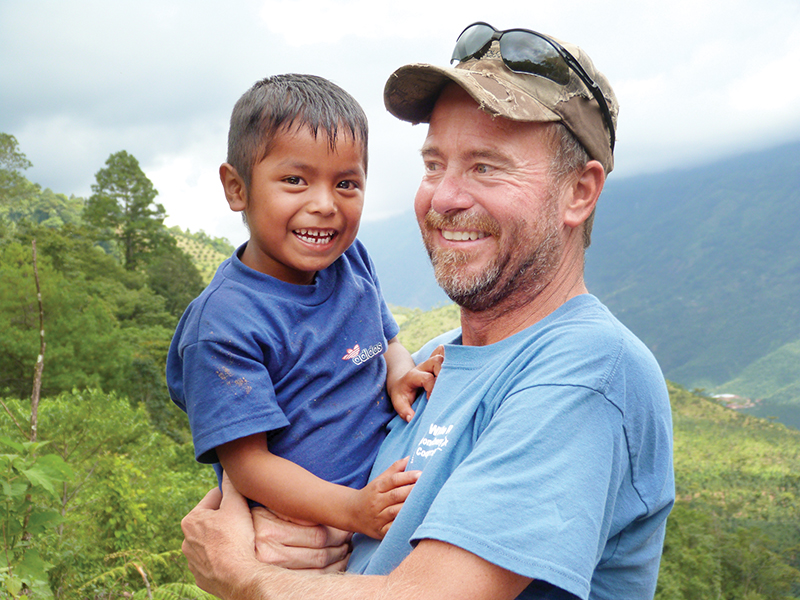
Carroll White REMC lineman Gary Kirk shares a smile with a grateful Guatemalan boy during a farewell fiesta held in honor of the Indiana REMC lineworkers who built some 20 miles of line across rugged terrain to three remote mountain villages in western Guatemala in late summer of 2012. The international project was the first ever for Indiana crews.
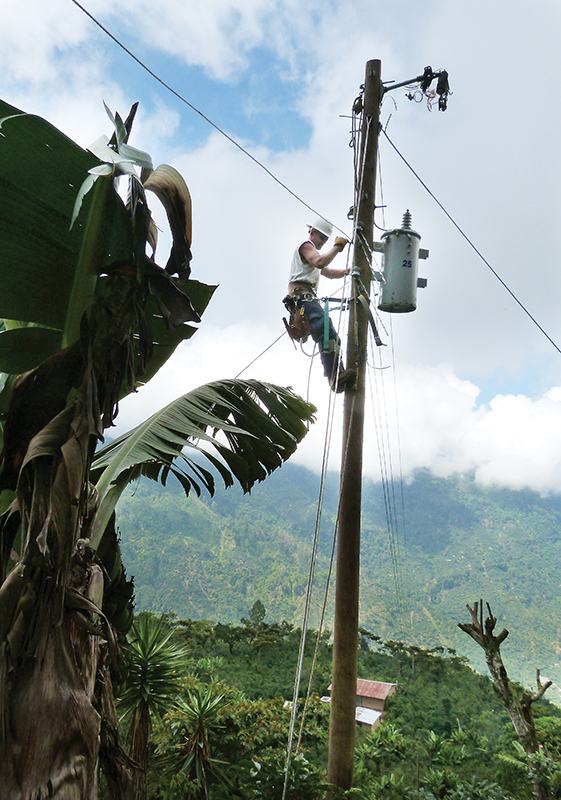
Chad Griffin, a lineman from South Central Indiana REMC, connects a transformer to a new pole for a village in the Cuchumatanes Mountains of Guatemala. Unlike working in the rolling farmland of home, Hoosier linemen here would climb 30 feet up one side of a pole, and be able to look straight down a 1,000 foot gorge on the other side.
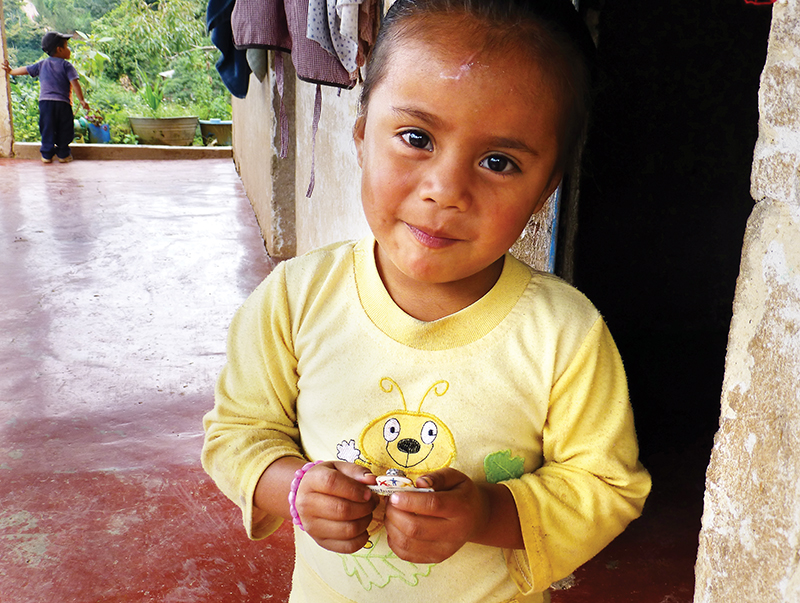
A young Guatemalan girl holds a “Touchstone Energy Cooperatives” pin given to her by Dennis Weiss, Kankakee Valley REMC CEO. The pin will help her remember the time when electricity came to her home — and the “power of human connections” with the Indiana lineworkers who brought it to her, her family and her village.

Young coffee beans, the area’s major crop, grow on the steep mountain sides. Electricity will allow the local growers to process the beans themselves and skip a middle man.
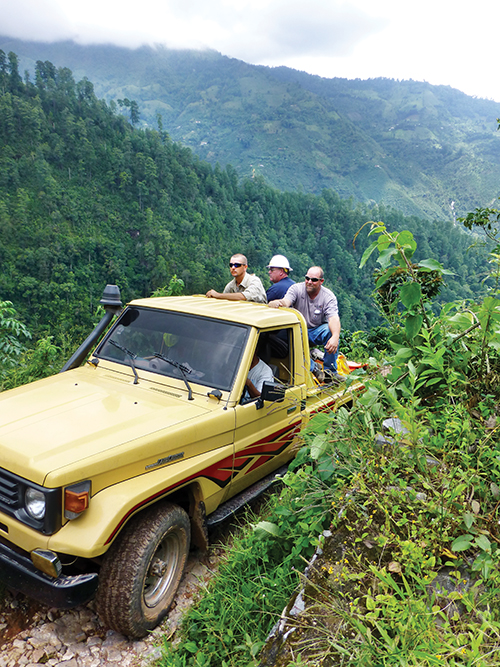
Craig Smart, Jasper County REMC, from left, Steve Campbell, SCI REMC, and Jeff Morrison, Tipmont REMC, hitch a ride up the mountain to begin a day’s work. The crews spent their nights in a larger village in the valley, then relied on locals to drive them and their gear up and down the mountain in the backs of a rag-tag fleet of pick-up trucks.
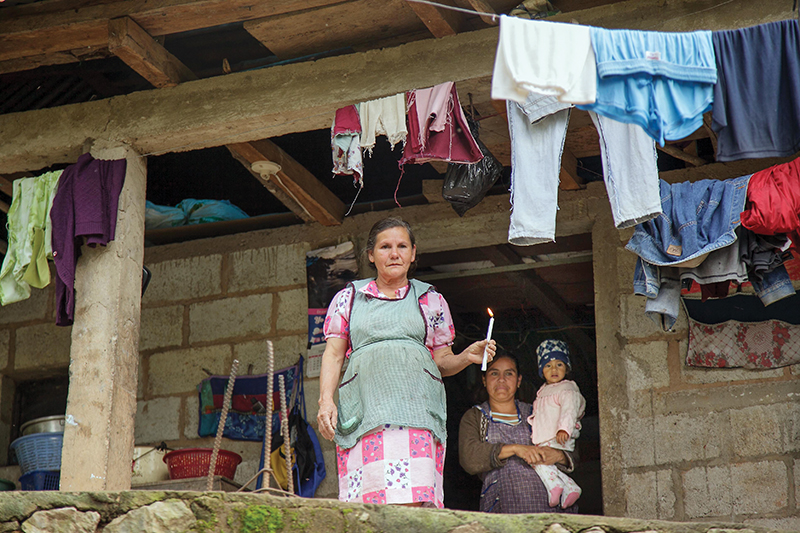
Electric light will mean candles and oil lamps will soon be a thing of the past for the extended families living in the ramshackle homes.
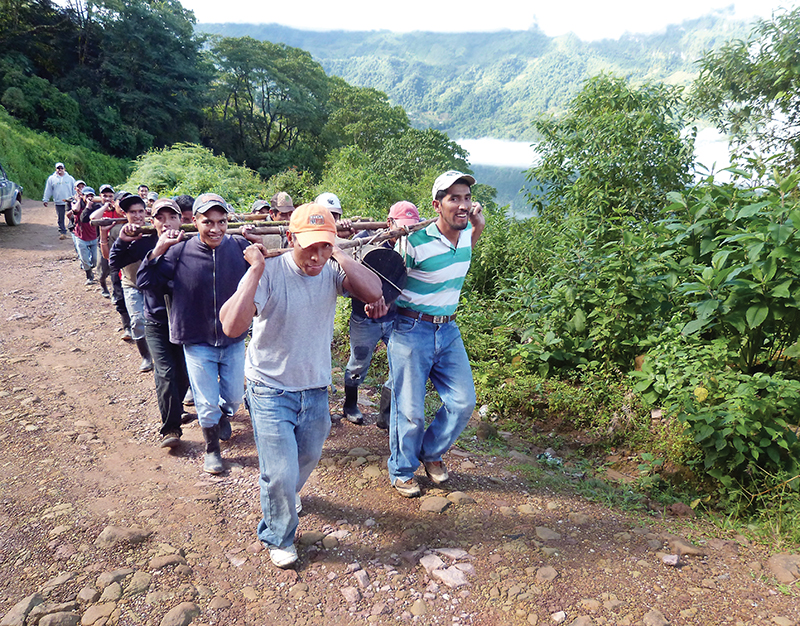
Volunteers helped the Indiana crews with much of the heavy lifting — such as carrying this 1,000-pound utility pole up the rocky mountain road.
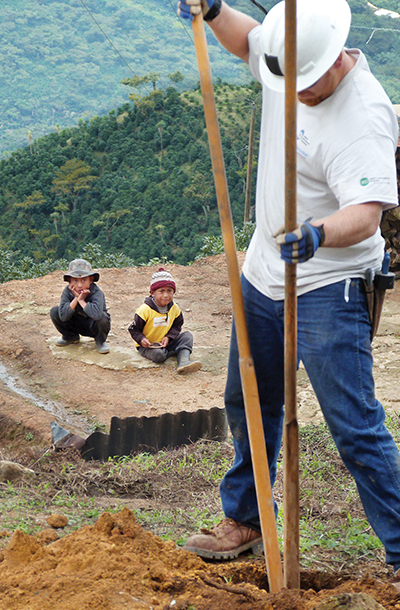
Holes for the poles, 6-feet-deep or more, had to be dug by hand. Two little boys watch Ross Egenolf, from Utilities District of Western Indiana REMC, work on one. Crews, with the help of the local men, dug some 50 to 60 holes for poles and their anchors.
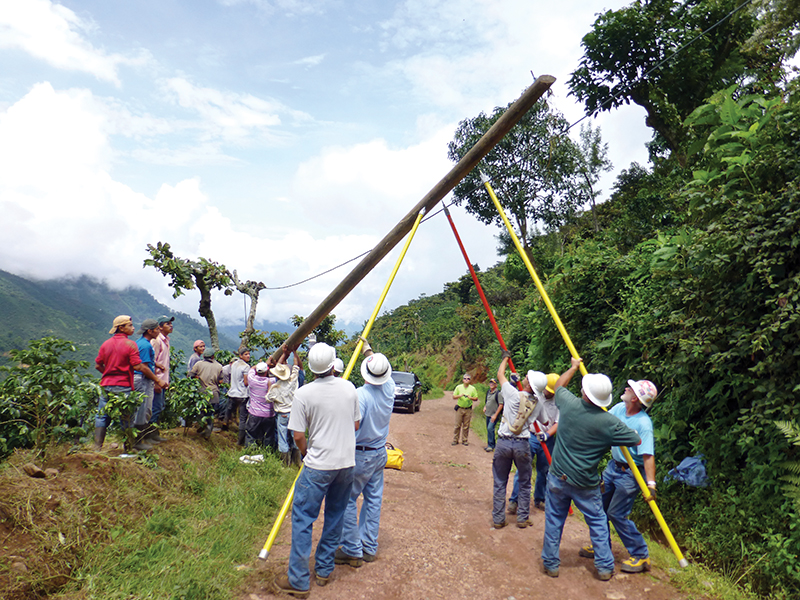
In a scene straight out of the old Rural Electrification days of the United States, before utility trucks were equipped with augers and hydraulic lifts, a pole is carefully lifted and dropped into its hole.
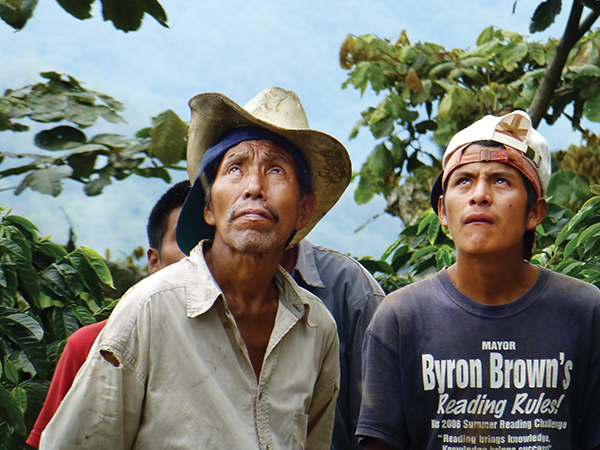
Two Guatemalan men look on as poles are set and then climbed by linemen to install the hardware and, ultimately, string the power lines. Instead of the leg spikes used by Indiana crews to climb the poles, the local lineworkers climb using ropes, knotted into stirrups, which are tied around the poles.
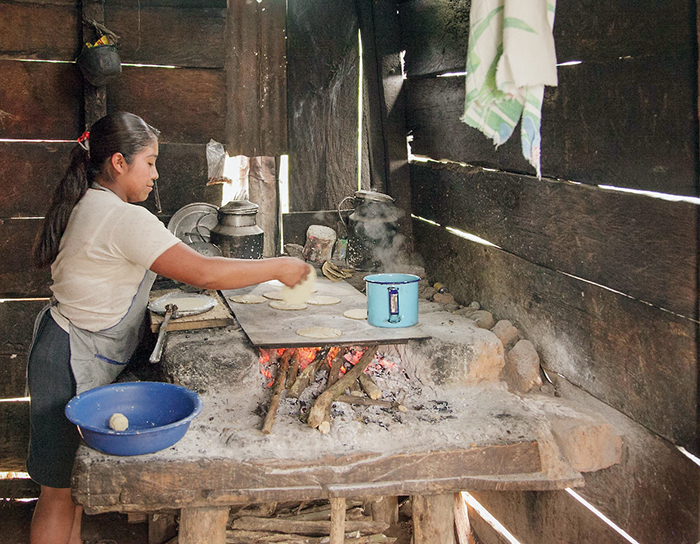
A local woman cooks corn tortillas for the linemen over an open fire in her kitchen. The villagers provided the daily meals, mostly rice, beans, tortillas and chicken, for the crews.
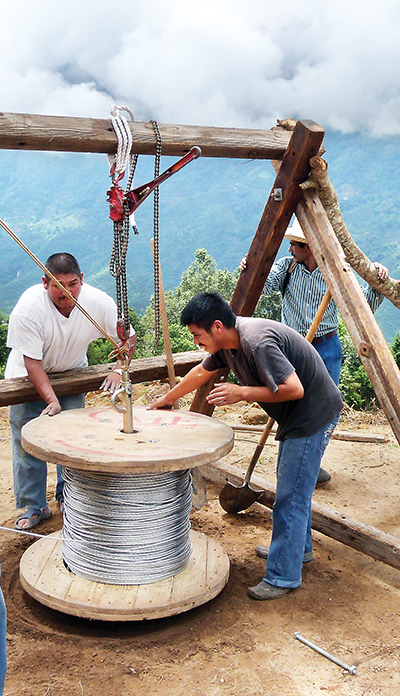
Using a hand chain-hoist, utility pole crossarms and other lumber, the line crews rigged a makeshift frame to support a 1,000-pound “payout reel” of wire allowing it to unroll. Locals keep the coil steady and rolling as the wire is pulled from strand to strand.
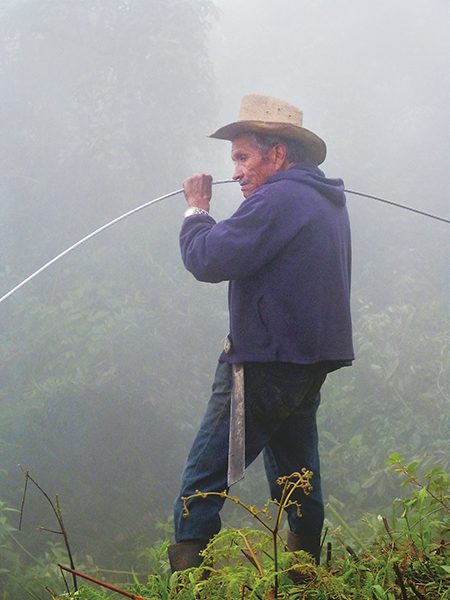
In the midst of a mountaintop cloud, an old man holds up a strand of wire to keep it from being snagged in heavy vegetation as it’s pulled from the reel and strung through a ravine. Some days, the co-op linemen were assisted by up to 30 local Guatemalan villagers eager to lend a hand.
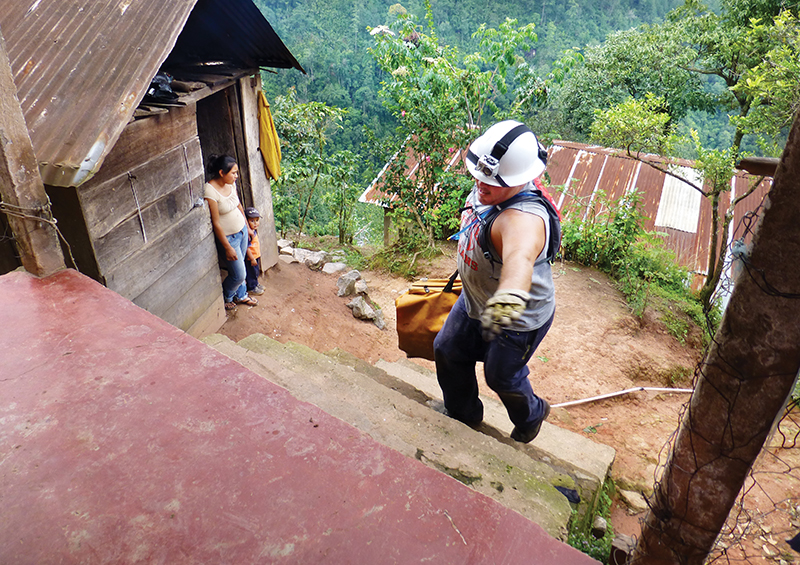
Brandon Foutch, Carroll White REMC, climbs with his equipment up the steep steps of a home. It was the only route to a utility pole high in the jungle behind. A woman and her son stand in the entry of the detached kitchen below.
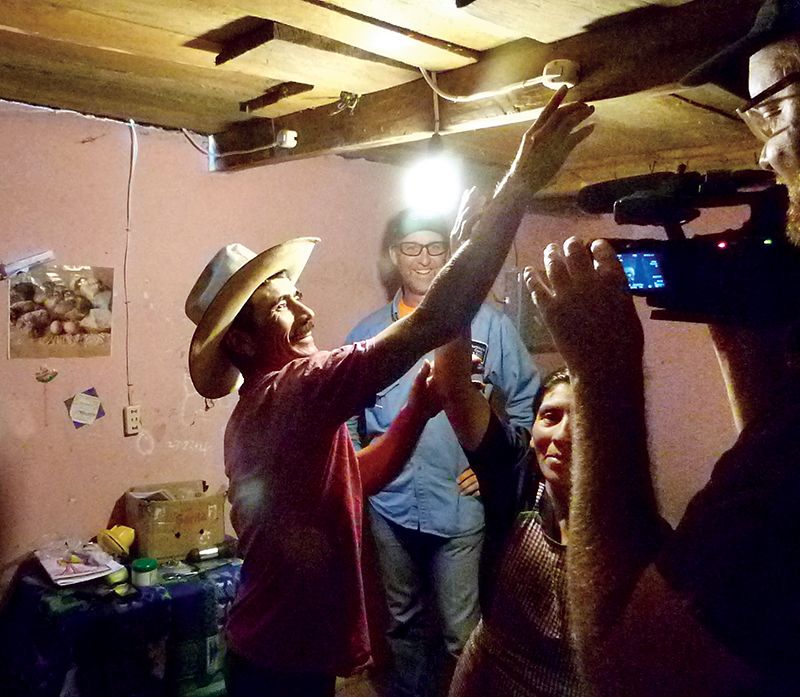
With the flick of a switch, a long-awaited electric light comes to life for the first time in a home shared by this Guatemalan couple. Looking on with a smile is Bartholomew County REMC lineman Bobby Waddle. Videographer Vinnie Manganello, part of a crew from Indianapolis PBS station WFYI, captures the moment for an upcoming documentary, “Power to the People,” that will chronicle the mission.
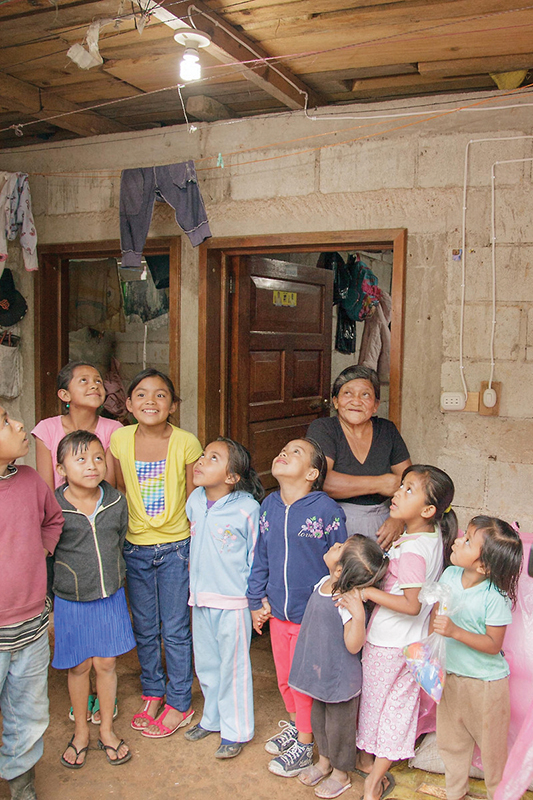
“Little Grandmother,” as she was called by the crews, Yasly Yasely Velasquez, and grandchildren stare up at the new light in their home, the first to be electrified on the mountain.
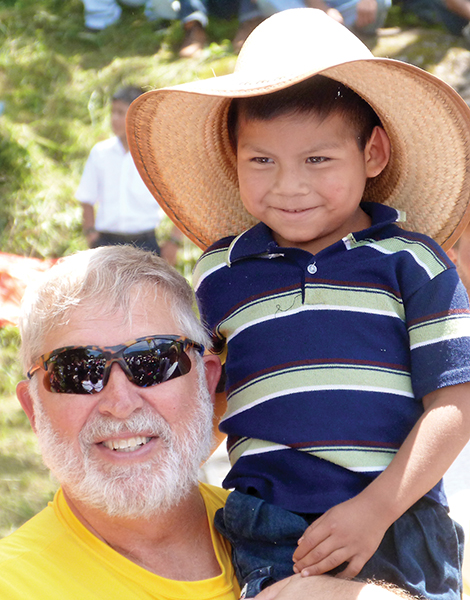
Terry Adkins, one of the supervisors who spent all four weeks in Guatemala, hoists one of the local children on his shoulder during a farewell fiesta.
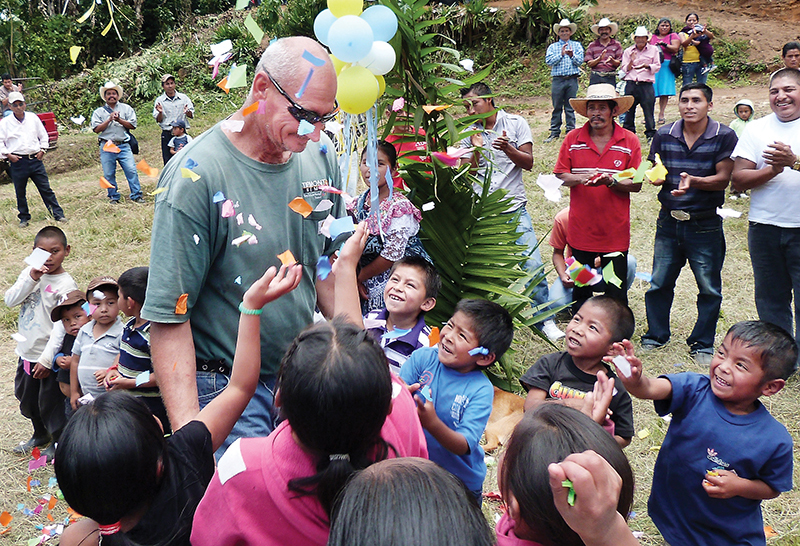
With the work complete, the linemen prepared to return to their homes and families — but not before they were given a heroes’ send-off that included certificates, hugs and a gauntlet of high-fives and confetti from the grateful children. Tipmont REMC’s Bob Palmer takes his turn in the spotlight.

Hoosier crews ‘power the world’
Indiana’s electric cooperatives sent 28 linemen and four supervisors to Guatemala in late summer to bring power to remote mountain villages in two, two-week shifts.
Team 1 included: Brandon Foutch, Carroll White REMC; Jerry Applegate, Clark County REMC; Terry Adkins and Gayvin Strantz, Indiana Statewide Association of RECs; Craig Smart, Jasper County REMC; Dennis Weiss, Kankakee Valley REMC; Kelly Neace, Kosciusko REMC; Chris Mynhier and Troy Sams, LaGrange County REMC; Carl Sneed and Chris Wesner, Orange County REMC; Warren Shuppert, RushShelby Energy; Steve Campbell, SCI REMC; Rob Hunger, Southeastern Indiana REMC; Matt Lowe and Jeff Morrison, Tipmont REMC; Jordon Clark, UDWI REMC; and Felix Vanner, United REMC.
Team 2 included: Bobby Waddle, Bartholomew County REMC; Matt Kent, Gary Kirk and Randy Price, Carroll White REMC; Adkins and Strantz, Indiana Statewide; Jeff Moore, Kosciusko REMC; Rob Schwartz, Miami-Cass REMC; Todd Myers, Northeastern REMC; Larry Herbert and Tim Smith, RushShelby Energy; Troy Fischer and Chad Griffin, SCI REMC; Bob Palmer, Tipmont REMC; and Ross Egenolf and Jeremy Feltner, UDWI REMC.
Also accompanying the groups were freelance and WFYI filmmakers working on “Power to the People,” a documentary of the mission, which will air on PBS stations early next year: Diane Willis, producer; Jim Simmons, producer; Chris Elberfeld, videographer; Vinnie Manganello, videographer; and Kent Newton, logistics coordinator.

